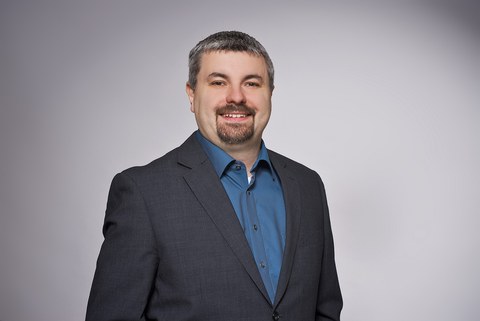ZIH-Colloquium 2025
Table of contents
The ZIH colloquium is a public event and takes place usually the 4th Thursday of each month. Below you will find the current and former dates with all necessary information. You are cordially invited!
26 June 2025, 3:00 p.m., APB-1096
Assoc. Prof. Josué Manik Nava-Sedeño (National Autonomous University of Mexico, UNAM) - „How movement shapes life: the interplay between stickiness and motility in cancer invasiveness“
Tumors are classified as benign or malignant, depending on whether their cells are confined to the main tumor mass, or whether they are able to invade other tissues. It is generally assumed that tumor cells become malignant when they lose adhesive contacts with neighboring cells in a process called epithelial-mesenchymal transition. However, recent observations suggest that malignant tumor cells may retain adhesive properties while still performing long excursions into surrounding tissue. Using a mathematical model, it is shown that tumors can gradually become malignant purely by increasing the probability of long-distance cell movement, undergoing cyclic metastatic processes at high levels of adhesion and motility.
Josué Manik Nava-Sedeño is an associate professor at the National Autonomous University of Mexico (UNAM). He earned his PhD in Mathematics at TU Dresden, where he later worked as a postdoctoral researcher on statistical methods for medical decision-making. His research involves mathematical modeling of biological systems and cellular automata. He has taught numerous undergraduate and graduate courses, and has advised dozens of dissertations on modelling, dynamical systems, and stochastic processes.
27 March 2025, 3:00 p.m., Online BBB
Dr.-Ing. Michael Klemm (Principal Member of Technical Staff in the Compilers, Runtimes, Libraries and Tools team at AMD) - „OpenMP® Target Offloading for AMD GPUs and APUs“ slides
Today’s supercomputers are heterogeneous systems and GPUs have been established as accelerators to boost the execution of data parallel algorithms. However,programming GPUs remains complex and usually results in code that is not portable between GPU vendors. Many software packages reflect this circumstance and provide tailored implementations for HIP, CUDA, and OpenCL.
This talk has two parts. First, it will introduce target offloading using the OpenMP API, an easy and portable way to exploit GPUs. It will also provide a glimpse at new features of the OpenMP API version 6.0 specification. Second, the talk will explain the architecture of the MI300A accelerator and the process of offloading to it, including the software changes required to take advantage of new features like Unified Shared Memory.

Dr. Michael Klemm (Principal Member of Technical Staff in the Compilers, Runtimes, Libraries, and Tools team at AMD)
Dr. Michael Klemm is a Principal Member of Technical Staff in the Compilers, Languages, Runtimes & Tools team of the Machine Learning & Software Engineering group at AMD. He is part of the OpenMP compiler team, focusing on application and kernel performance for AMD Instinct accelerators for High Performance and Throughput Computing. Michael Klemm is the Chief Executive Officer of the OpenMP Architecture Review Board.
28 January 2025, 11:00 a.m., APB-1096/ Online BBB
Prof. Leah Edelstein-Keshet (Department of Mathematics, University of British Columbia Vancouver, Canada) - „Data, models and simulations of single cell motility“
Immune cells such as neutrophils (white blood cells) can navigate to sites of infection. Their directed motility is regulated by patterns of activity of intracellular proteins (such as Rac). That activity determines where filamentous actin (F-actin) will assemble and power cell protrusion. Modeling these systems has been one of my interests for some time. A challenge has always been to link spatial (PDE) models of the relevant proteins to cell shape and motion. Here I will describe two recent projects that greatly benefitted from the Morpheus software made publicly available by the TU Dresden group (Lutz Brusch, Jörn Starruß). In (1), a theoretical PDE model for Rac and F-actin that we studied analytically (PhD student Jack Hughes and collaborator Arik Yochelis) was visualized in Morpheus simulations of motile cells to show dynamic transitions between polar and ruffling cells (MSc student Jupiter Algorta). In (2), optogenetic experiments by Jason Town and Orion Weiner (UCSF) were modeled and simulated in Morpheus (by Jupiter Algorta) to explore the hypothesis that Rac promotes its own local inhibitor. Morpheus allows us to implement the PDE dynamics on the edge of a cell and to track the protrusion, motion, and response to stimuli of that cell.
(1) J. M. Hughes, S. Modai, L. Edelstein-Keshet, A. Yochelis: Travelling waves and wave pinning (polarity): Switching between random and directional cell motility. arXiv:2410.12213, 2024.
(2) J. Algorta, A. Fele-Paranj, J. M. Hughes, L. Edelstein-Keshet: Modeling and Simulating Single and Collective Cell Motility. Cold Spring Harbour Perspectives in Biology, 2024.

Prof. Leah Edelstein-Keshet (Department of Mathematics, University of British Columbia Vancouver, Canada)
Prof. Edelstein-Keshet studied Mathematics at Dalhousie University (Halifax, Canada) and received her doctorate in Applied Mathematics from the Weizmann Institute of Science (Rehovot, Israel) in 1982, where she worked with Lee Segel.
Via Brown University (Providence, USA) and Duke University (Durham, USA), she moved to the University of British Columbia (Vancouver, Canada) Dept. of Mathematics in 1989.
Her research focuses on mathematical models of cell motility, and collective behavior. She is the author of a popular interdisciplinary text book „Mathematical Models in Biology“ (SIAM). Prof. Edelstein-Keshet is a former president of the Society for Mathematical Biology (SMB, 1995-1997) and Fellow of SMB and SIAM (2014). She was awarded the Arthur Winfree Prize of SMB (2021), the John von Neumann Prize Lecturer of SIAM (2022) and the CRM-Fields-PIMS Prize of the Canadian Mathematics institutes (2025).
